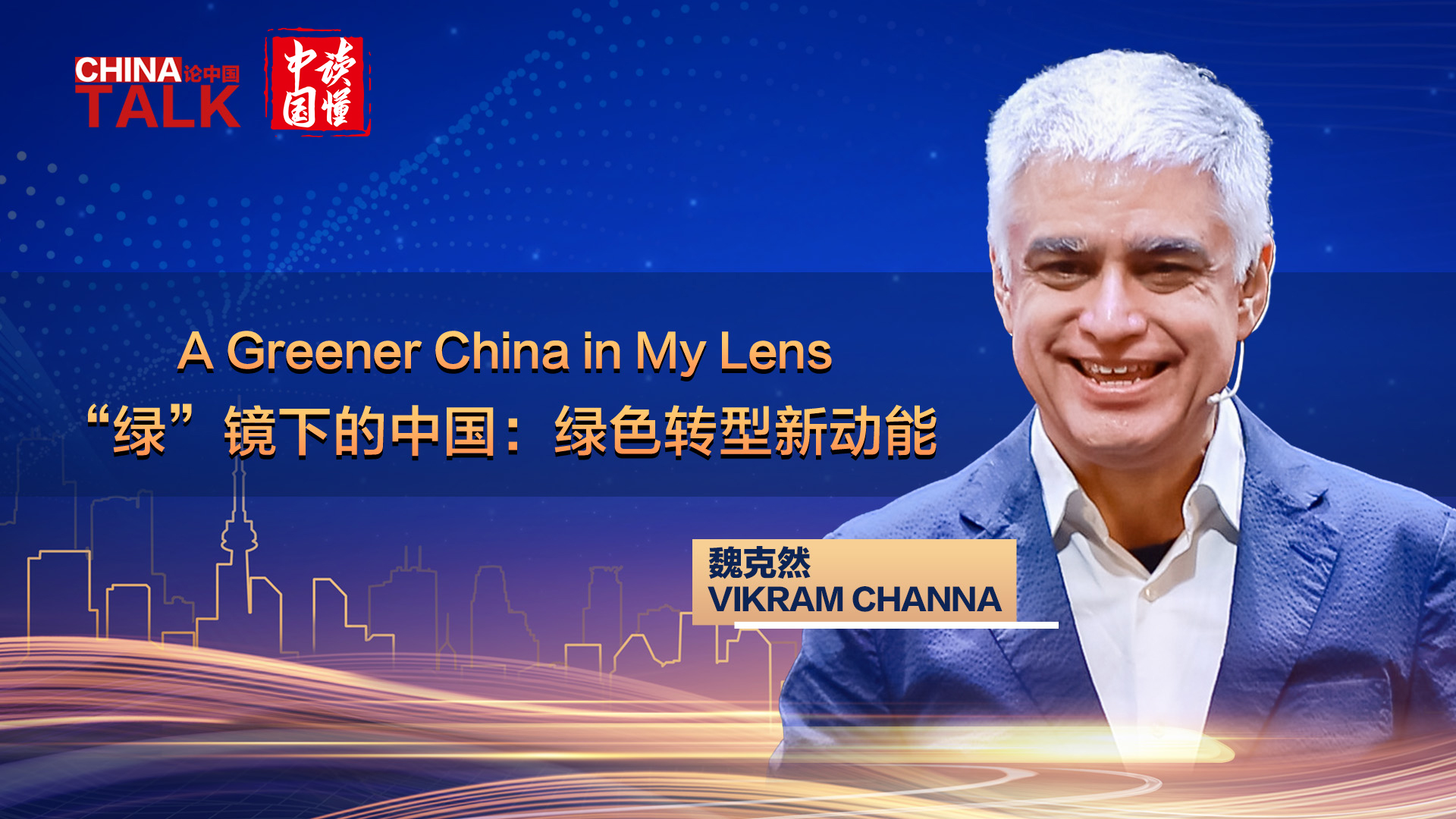“大漠里的农民沿用古代的智慧发明了草方格,让沙漠变成了绿洲。”探索亚太电视网内容副总裁魏克然通过纪录片的镜头,见证了中国一个个“绿色奇迹”。他记录下三代人把荒原变林海的塞罕坝精神;他看到借助5G智能电网,中国正在打造一个零碳未来。一起跟随魏克然的镜头,看看中国如何传承古代农耕智慧,利用创新科技,打造绿色强国。

作为这次“读懂中国”主题演讲的开场嘉宾,我想先介绍一下这两个稻草人。去年春节期间,我在福建的一个村子里“偶遇”了它们,当地的导游向我解释了这两个稻草人的意义以及它们代表的涵义,让我一下子豁然开朗。我在中国拍了二十年纪录片,一直通过影像发现中国,而在那一瞬间,我对中国有了全新的理解。中国将对世界产生何种影响,她将如何改进世界以应对21世纪人类面临的共同挑战?
我的思绪回到了20多年前,我第一次来到中国、来到北京时的情景,那次经历我记忆犹新。那是2002年3月底,就在我抵达的前一天,一场多年未见的沙尘暴席卷了北京,我依然清晰记得,蒙上了一层黄沙的车辆和道路就像是末日电影或小说里的场景。中国此前几十年的快速增长以环境为代价,让北京在狂啸的戈壁沙漠面前脆弱无比。中国这个五千年的文明,是世界上持续时间最长的文明,当时正在奋力直追,并以惊人的速度转型。那时,中国已经成为“世界工厂”,数以亿计的中国人摆脱了贫困,走上致富之路,但也付出了代价。我记得,那十年间我制作了多档节目,记录中国崛起的故事。然而在进行后期制作时,我们却发现调色工作是一个巨大的工程。由于污染,天空灰暗是我们拍摄期间经常遇到的情况。我还记得北京在2008年夏季奥运会的样子,那是一场标志着中国崛起的盛会,让世界叹为观止。然而,我几次来北京始终躲不掉有些刺鼻的黄褐色雾霾。后来,情况有了转机。2019年5月,我们摄制组进行踩点,在当地环保部门的陪同下,我们来到了宁夏腾格里沙漠。我们虽然身处沙漠,但是很难觉察是置身在沙漠里,只有一小片精心保护的沙丘,提醒着我们这里曾经的样貌。
在中国西北,当地农民艰苦努力,奋斗数十年,用他们的智慧发明了这些特别的草方格,再结合一些特制的工具,最终让沙漠销声匿迹。后来我还见证了另一个关于奉献的故事。与宁夏的农民一样,这个故事也十分令人动容,这就是塞罕坝的故事。塞罕坝当地三代人不懈努力,在整个地区植树造林,扭转了过去100年水土流失的局面,改变了工业发展带来的负面影响,创造了一个绿色奇迹。中国的努力得到了联合国的认可,因为中国的森林覆盖率经过十年的努力,进一步提高至24%。最近我们把塞罕坝治沙的成就搬到了屏幕上,一部独特的竞技真人秀节目——《游戏星球:沙漠治理》。我们请游戏设计师沉浸式地体验当地农民的生活,然后把他们治沙的行动设计成电子游戏,以激励并启发中国和海外的年轻观众,告诉他们比如荒漠化等诸多挑战是可以通过毅力和努力治理好的,这就是中国方式。
如今,我居住在北京,随时都能看到美丽湛蓝的天空,可以说,蓝天已成为北京多数情况下的标配,而不再是2014年短暂的“APEC蓝”。后来,我还去了张家口踩点,我们看到了智能电网是如何通过采用5G技术并配备最先进的逆变器,从源头解决问题,稳定输送通过风能、太阳能和水力生产的清洁电能,其目标是在2060年为整个北京地区乃至全国提供零碳能源。2022年,该方式已经在北京冬季奥运会期间进行试点运行,确保整个奥运活动期间所有的能源供应都是清洁、绿色的。
中国,这个曾经的“世界工厂”正在升级其价值链,伴随着一系列自主研发技术的诞生,中国已有足够的能力,走上新的可持续发展之路,以低端制造带动增长的旧模式正在逐步退出。深圳的“山寨经济”已经让位于人工智能引领的创新型经济,以及高端和绿色制造业,其中就包括高效能电池行业。而高效能电池为中国本土的新能源汽车行业的腾飞提供了有力的支撑,中国新能源汽车史无前例的成功,助力中国成为了全球最大的汽车制造国。
“不管黑猫白猫,能捉老鼠的就是好猫。”中国前领导人邓小平曾以黑猫和白猫为例提出求真务实的理论。如今这一理论也与时俱进,随着高科技创新成为新常态,“黑猫白猫”如今或许也要开启“机器猫”时代。
中国这座“世界工厂”曾一度饱受污染之苦,现已发展成为世界领先的绿色公共产品的制造者和出口者。中国是否有足够的能力来应对人类面临的共同挑战,比如,气候变化相关问题,以及那些影响人类可持续发展的挑战。二十年弹指一挥间,从那年三月份,我第一次亲历黄沙肆虐后的北京,到如今,中国已实现华丽的转身。曾几何时,蓝色牛仔裤诠释了美国精神,绿色产品是否也会成为中国的代名词?是否在不远的未来,廓清各国间的迷雾?
最后,我想重提一下,这两个福建的稻草人,它们让我坚信中国经济的提质升级,以及由此可能带来的整个世界的转型。这两个稻草人并不普通,请再仔细看一下这张图片,它象征着中国源远流长的农耕与翰墨交映生辉的文化 ,即耕读文化。这两个稻草人代表了古代的工程师和创新者,他们奠定了基础造就了世界上持续时间最长的中华文明。耕读文化,是中国文化真正意义上的源代码,是中国文化的基因。传说中的“三皇”,伏羲、神农和黄帝都曾通过观察、记载、研究天体运行规律,考察四季循环变化,他们发明的历法在今天依然随处提示着中国人不忘文化根基,比如,微信里就有相关的应用。中国一代代人传承着老祖宗留下来的智慧,比如,奠定农业文明根基的治水之法,以及至今仍然启发我们的求知若渴的精神。由后朝学者所编纂《易经》也强调了这些中国智慧,并深植于这三位古代先贤工程师的思想中。套用林肯的励志名句“民有,民治,民享”,中国从祖先们那里所继承的精神,是否会再次启示我们?从本质上说,人类属于自然,依靠自然,为自然而存,而且始终是其中的一部分。
谢谢大家。
A Greener China in My Lens
I want to begin my sharing on China Talk on Understanding China “with these two strawmen that I accidentally encountered. In a Fujian village last Chinese New Year. As the local guide revealed the meaning of these two gentlemen, and what they stood for, suddenly in one fell swoop, a 20-year journey of discovery in China shaped through documentary impressions, would reveal a new understanding of China. What kind of impact would she have on the world? How could it leave the world better placed to tackle common challenges of the 21st century?
My mind went back to one of the first visits to China more than 20 years ago to Beijing. One that has always stayed with me.It was late March of 2002. I arrived the day after a most horrible sandstorm in years had hit the city. I still remember vividly the images of sand-covered vehicles, pathways, as if out of an apocalyptic movie or novel. Previous decades of rapid growth and neglect of the environment had left Beijing vulnerable to the fearsome Gobi. A 5000-year-old civilization, the world’s most continuous culture was playing catch-up at a breakneck speed of transformation.China by then had become the "factory to the world."It was pulling millions out of poverty and setting them on a path of relative prosperity, but at a price.I remember producing several shows during that decade that archived China’s arrival story: from the engineering marvels ancient and modern, the impact of high-speed trains on lives of the people,the first stirrings of a technological revolution,and truly it was an impressive showcase – one indicative of a bright future that beckoned.Yet, in the editing rooms as we put these shows together, we shuddered at the painful task of color correcting, the dark polluted skies that we encountered so often in these films.I still remember Beijing in the years after the Summer Olympics in 2008. Even as China’s coming out party had left the world awestruck.A pungent yellow smog was a constant companion during many visits that followed.But then things began to change. A decade later, in May of 2019, a group of us were on a site visit to Ningxia’s Tengger Desert with the local environmental officials. We were in the desert but it was very hard to spot it. Only a very carefully preserved patch of pure sand dune in its resplendent form showcased what had stood before.
In northwestern China, backbreaking sacrifices of local farmers, going back decades by using their ancient wisdom found in these special straw grids, together with some custom-innovated implements, had the power to make the desert disappear. Later I would discover another story of sacrifice just like the farmers in Ningxia. This was the emotive story of the Saihanba spirit. Here a local community fought a three-generation battle to reforest the entire area denuded by the last 100 years of damage, because of industrial development,and created a green miracle. Such efforts are recognized by the United Nations,as increased forest cover in China has increased to nearly 24 percent over the past ten years. We recently captured the story of such an accomplishment in a unique competitive reality series called Can Video Games Change the World? For the show we invited video game designers to immerse themselves into the lives of local farmers and gamify their efforts into actual video games that serve to excite and inspire young viewers in China and abroad –that challenging issues like desertification can be addressed through the determined efforts involving local communities – China Style!
By now I was already living in Beijing. In any given week, gorgeous, blue blue skies,pure blue skies tended to dominate more often than not. This was no longer the temporary APEC Blue (in 2014).Later, in another site visit to Zhangjiakou, close to Beijing in Hebei Province, we witnessed smart electricity grids using 5G technology, with cutting-edge inverters to stabilize, at source, clean power being generated using wind, solar and hydro. The goal is to supply zero-carbon energy to the entire Beijing area by 2060 and to the entire country itself. This effort had already been piloted in 2022 for the Winter Olympics in Beijing making the energy supplies to the entire event clean and green.The "factory of the world" was moving up the value chain with a slew of homegrown technologies that had the ability to put China onto a new sustainable path. Low-end manufacturing-driven growth was ebbing. Shenzhen’s "shanzhai economy" was giving way to an AI-led innovation and high-end manufacturing and green manufacturing – that now includes efficient batteries that power China’s home-grown electric vehicles industry. Its unprecedented success has already made China into the largest automaker in the world.
Heimao baimao – former Chinese leader Deng's pragmatic (maxim of) "black and white cats" were indeed evolving into a new era of jiqimao or robot cats, with this high-tech innovation a new normal.
Could the "factory of the world"that once polluted, now evolve into the world’s leading manufacturer and exporter of green public goods, provide a tool kit for humanity’s common challenges, from climate change issues to those that concern sustainable development? In the twenty years since that March day when I witnessed the aftereffects of the desert’s fury, it is indeed a full circle for China’s journey. Once upon a time, blue jeans defined America, can clean and green products from China achieve the same?And in the process clear the fog between nations in the near future?
At the end, I would like to draw you back to the two strawmen from Fujian. From here lies my sense of conviction that this transition to a new economy and to even a new world is perhaps more than skin-deep. For these strawmen are not ordinary – look carefully into the image again – it signifies China’s timeless scholar-farmer culture, also known as Gengdu Wenhua.They are the ancient engineers and innovators who built the foundations of the world’s most continuous living civilization.It is Gengdu Wenhua that is indeed the source code of this culture,its very DNA, where three mythic emperors – Fuxi, Shennong and Huangdi all observed, recorded and studied the passages in heavens above the cycle of nature on Earth. They invented the calendar that still reminds contemporary China of its roots even on the app WeChat. They passed onto generations the critical knowledge of flood control that would form the basis of this agricultural civilization,and a deep thirst for knowledge that inspires us even today.The iconic Book of Change or Yi Jing that was compiled later and underpins so much of Chinese wisdom is ultimately also grounded in the reflections of these ancient engineers of China. If Lincoln inspired us all with the idea“of the people, by the people and for the people,” can China’s inheritance from its ancestors remind us once again how intrinsically–we are “of nature, by nature and for nature,"and always a part of it?
Xiexie. Thank you!

